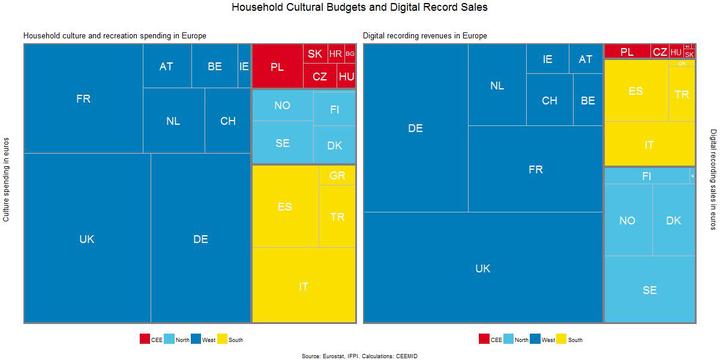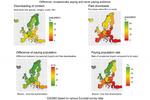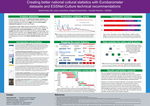CEEMID

CEEMID is a data integration system that could provide to be a model and starting point of building a European Music Observatory based on open data, open-source software using best statistics, data science and AI practices. CEEMID has created thousands of high-value, hard music industry indicators using open data sources, industry data sources, surveys and various APIs to relevant other data sources. (More on ceemid.eu website.)
CEEMID is aiming to transfer thousands of indicators and a verifiable, open-source software that creates them to the European Music Observatory to give Europe-wide acces timely, reliable, actionable statistics and indicators for the music industry, policymakers and music professionals. (Read more about our data coverage)
CEEMID is a private initiative. We developed data products for the needs of the industry: to calculate adequate royalty price (tariff) levels, to calculate adequate compensation for damages, to design better grants, to advocate better CCI policies, to pinpoint discriminative taxation of the industry, to monitor public performance licenses, to calculate the size of the value gap, to train algorithms that find new audience for small nation repertoires abroad, and so on. Because the industry is made of microenterprises all over Europe and the world, and even larger organizations, such as collective management societies are at most SMEs, the industry has very limited market research or research & development capacities. This makes .
Data Coverage
We believe that CEEMID is a viable piloting point for the European Music Observatory. Our primary goal is to provide thousands of indicators for the three pillars of the European Music Observatory (See presentation.
- Pillar 1: Music Economy of Europe
- Pillar 2: Music Diversity and Circulation
- Pillar 3: Music, Society and Citizenship
- Pillar 4: input data for business and technical innovation, i.e. the Innovation pillar.
Because we cover all areas of innovative uses (predictive AI modelling, forecasting, royalty setting and pricing, audience targetting, policy indicators) we believe that further data domains must be covered.
Geographical coverage
CEEMID is primarily focusing on data from the European Union. We aim to create indicators for each European Union member state, and whenever possible, each European NUTS1 level region (provinces, Bundeslander, etc) and NUTS2 level regions. We aim to introduce city level indicators in 2020.
Our secondary focus is Europe, including the European Economic Area, (potential) candidate countries, and the United Kingdom.
Whenever possible, we collect comparative data globally, particularly from countries with a developed, strong music market, such as Australia, Canada, Brazil, Japan, South Korea and of course the United States of America.
Historically CEEMID started out as the Central and Eastern European Music Industry Databases out of necessity following a CISAC Good Governance Seminar for European Societies in 2013. The adoption of European single market and copyright rules, and the increased activity of competition authority and regulators required a more structured approach to set collective royalty and compensations tariffs in a region that was regarded traditionally as data-poor with lower quantitiy of industry and government data sources available.
In 2014 three societies, Artisjus, HDS and SOZA realized that need to make further efforts to modernize the way they measure their own economic impact, the economic value of their licenses to remain competitive in advocating the interests vis-à-vis domestic governments, international organizations like CISAC and GESAC and the European Union. They signed a Memorandum of Understanding with their consultant to set up the CEEMID databases and to harmonize their efforts.
CEEMID by designed aimed to follow the best European practices on statistical harmonization and was already featured as an innovative best practice in the 40th anniversary of Pan European Surveying seminar in 2015. As an initiative born out of necessity, it aimed fill in the gaps of underdeveloped official cultural statics by following the guidelines of Eurostat’s ESSNet.
We believe that a very large segment of CEEMID’s and the European Music Observatory’s data coverage is based on public-interest data that is collected by public authorities. Therefore, CEEMID was based on the regulatory framework provided by the Directive on open data and the re-use of public sector information provides a common legal framework for a European market for government-held data (public sector information). It a regulatory framework that is built around two key pillars of the internal market: transparency and fair competition. In our view, these principles should apply to European Music Observatory, too.
Open source, open data, open collaboration
In the EU, open data is governed by the Directive on open data and the re-use of public sector information - in short: Open Data Directive (EU) 2019 / 1024. It entered into force on 16 July 2019. It replaces the Public Sector Information Directive, also known as the ‘PSI Directive’ which dated from 2003 and was subsequently amended in 2013. The founder of CEEMID, Daniel Antal has been involved in Open Data and PSI since 2008.
We believe that the European Music Observatory must rely on open-source statistical software written in the R statistical language like CEEMID. (Read why.)
CEEMID uses the open source statistical programming language R, and various open source R programs. CEEMID also releases some of its customary program code developed to create its indicators (See open data on this site). This allows an open collaboration with statisticians working in national statistics authorities and in independent research institutions in the EU and globally. For example, this allowed us to compare test results on calculating economic impact indicators for the creative industries and other industries with the UK statistical office.
The use of open source software and the open source R statistical language allows a continuous peer-review of data ingestion, processing, corrections and indicator creation by statisticians, data scientists and academics. Statistical products of national statistical offices, sometimes Eurostat itself, not to mention data providers that are not part of the system of national statistical offices, such as the European Audiovisual Observatory, are plagued with data errors that are corrected and amended relatively slowly.
Data integration instead of centralisation
From the originally envisioned, centralized, permission-based data structure, due to practical considerations, CEEMID switched to a more flexible, decentralized approach. This approach is based on continuous data integration, which requires permissions to use business confidential information only in use. This allowed a rapid extension of CEEMID to the whole of Europe and go even beyond. As a result of continous data integration it already includes hundreds of indicators foreseen in all pillars of the planned European Music Observatory.
While CEEMID is aware of and uses the metadata of CISAC’s, IFPI’s, EAO’s, and other industry sources' data, it does not contain this data, only when a user with permission for the use of these industry sources requires the integration of such data with other CEEMID data, or user-specific data. While this approach makes sharing results more cumbersome, it provided a path to increase the number of useful indicators from a few dozens to around a thousand. Furthermore, it exponentially increases the value of CISAC’s, IFPI’s or EAO’s data, especially when designing better royalty rates, or creating economic evidence for litigation. Take a look at a simple, non-confidential example blog post.
The CEEMID Music Professional Surveys are anonymous surveys about the live music and recording markets and granting schemes. The surveys have been filled out by about 4000 musicians, technicians, managers (and 2000 filmmakers) about the tour destinations, concert budgets and average audiences, various royalty receipts from streaming services, physical and digital sales, YouTube, Bandcamp. We are also creating comparable statistics with all EU national statistics on life satisfaction, economic expectations, income and economic situation and other characteristics of music and filmmaker professionals.
CEEMID makes sure that the Client’s data (collective management organizations, music distributors, music export offices, music granting agencies) are correctly integrated with our survey data, statistical and big data sources, with industry data and the Client’s own transactional financial, licensing, granting or processed data. We are handling professionally data errors, missing data, currency translations and other problem areas.
Data sources
Nationally representative CAP surveys of music users and film viewers.
Anonymous CEEMID Music Professional Surveys and CEEMID Audiovisual Professional Surveys about their work, incomes and costs. See example blog post.
Big data sources from various geolocational applications about events and location visits small video.
Automatic data retrieval from open data sources, including statistical data and EU-funded research. See example blog post
The Future of CEEMID
Historically CEEMID started out as the Central and Eastern European Music Industry Databases out of necessity following a CISAC Good Governance Seminar for European Societies in 2013. The adoption of European single market and copyright rules, and the increased activity of competition authority and regulators required a more structured approach to set collective royalty and compensations tariffs in a region that was regarded traditionally as data-poor with lower quantity of industry and government data sources available.
In 2014 three societies, Artisjus, HDS and SOZA realized that need to make further efforts to modernize the way they measure their own economic impact, the economic value of their licenses to remain competitive in advocating the interests vis-à-vis domestic governments, international organizations like CISAC and GESAC and the European Union. They signed a Memorandum of Understanding with their consultant to set up the CEEMID databases and to harmonize their efforts. The adoption of European single market and copyright rules, and the increased activity of competition authority and regulators required a more structured approach to set collective royalty and compensations tariffs in a region that was regarded traditionally as data-poor with lower quantitiy of industry and government data sources available, but quickly covered the whole European area (Read more about our data coverage and our pan-European geographical coverage.)
We believe that CEEMID could fulfil the functions of the European Music Industry if it would find a sustainable financing that makes access to all our data open. We need to be able to avoid the tragedy of the commons, where only a few industry users contribute to the financing of thousands of indicators that could potentially benefits tens of thousands of stakeholders in the EU.



